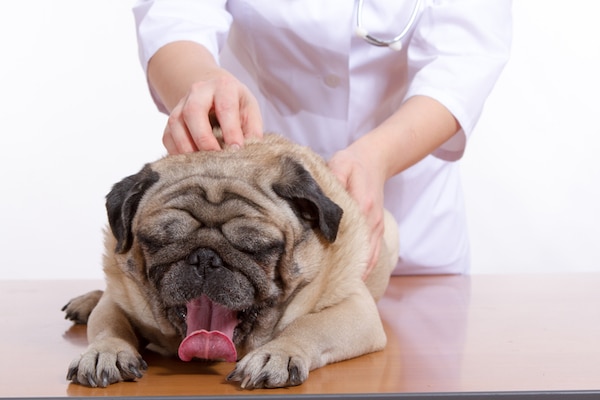Take this Dogster Quiz to find out if your dog is afraid of the veterinarian and if you can make your next vet visit less stressful.
It’s vet time! Your dog, Fluffers, is:
A. Not the best-trained dog, but he’s a good boy and your best friend.
B. A rescue dog who must have had a scary vet experience with his previous owners. Your last vet visit didn’t go well, so you’ve been putting off this appointment.
C. A few years old. You took obedience classes together, and you’ve exposed him to a lot of different people, places and things.
Before you schedule a visit with a new veterinarian, you:
A. Check your calendar and then call them.
B. Look through the website to read more about the vet who works there. You see that it’s a fear-free office, so you decide to call.
C. Go down of your list of prepared questions with the person who answered the phone before making the appointment.
The appointment is coming up! You:
A. Rush home after work, grab your dog, and race to the vet so you won’t be late.
B. Give your dog treats and talk to him in a baby voice as you put on his Thundershirt. You keep thinking about how he acted aggressively toward the vet tech last time.
C. Take a drive to the vet a few times in the weeks before the appointment to say hi to the staff, who give Fluffers his favorite treats. On the day of the appointment, you skip feeding him before you go and leave early enough so you don’t have to rush.
During the exam, you:
A. Notice your dog crouching down with his tail tucked under his legs. He yawns and has his ears pointed backward. Maybe he’s tired from the excitement?
B. You offer treats and coo at him because he looks scared, and you yell, “Oh my god!” whenever Fluffers makes a sudden movement.
C. Ask the vet questions, who answers while using firm but controlled touch on your dog. Fluffers looks a little uncomfortable during the examination, but he wags his tail whenever it looks like he’ll get a treat.

Pug yawning during exam by Shutterstock.
After the vet visit, you:
A. Take the advice of your vet, who said Fluffers was scared, and will train your dog so the next visit will be less scary.
B. Rush out of there. Your poor pup! If only Fluffers never had to visit the vet again!
C. Schedule your next appointment and tell the staff you’ll be back soon to say hi!
Mostly As – Scaredy Dog!
Without training, Fluffers doesn’t know what’s going on at the vet. Dr. Natalie Marks, an award-winning veterinarian at Blum Animal Hospital in Chicago, says your first step is to enroll in a basic obedience class. These classes “not only strengthen the human-animal bond,” she says, but also “socialize dogs so that they understand … how to interact in the world.”
Marks also suggests training your dog specifically for vet experiences. Get him used to be touched everywhere so future exams go smoother. Also visit the vet a few times for fun. “Walk into the lobby, relax for a few minutes to adjust to the sights, smells, and sounds, reward with a treat and then leave,” says Marks. It may take more fun visits for a very anxious dog, but he will relax eventually!
Mostly Bs – You Need to Chill
The vet isn’t freaking out your dog – you are! Your next vet experience can be positive, but you need to change your behavior. Vet prep starts at home, Marks says. Don’t feed Fluffers before the visit so he will have a stronger desire for treats. In the car, use calming products (pheromone sprays and Thundershirts) and play calming music. Marks says that with very scared patients, a veterinarian may suggest giving “short-term anti-anxiety medications, such as Trazadone and Lorazepam” before the visit.
According to Marks, good pet parent behavior at the vet includes “being quiet, using smaller, deliberate but nonthreatening movements, not acknowledging unwanted behaviors … and being aware and educated about anxious behavioral signs.” Bad pet parent behaviors include not properly preparing for the visit, rewarding unwanted behaviors, ignoring advice, speaking loudly, or in a high-pitched tone.
Mostly Cs – Cool as a Cucumber
Fluffers leaves the vet with a wagging tail, so keep doing what you’re doing! You did your homework and found a fear-free, AAHA-accredited animal hospital. Marks says that vet clinics with these accreditations are “progressive, consistent and of high quality … and allow a uniformly positive and stress-minimizing experience.”
You also know the signs of anxiety in dogs (yawning, ears back, strained look on the face, tail tucking, body crouched low or in guarded position, inappropriate defecation, diarrhea, panicky behavior, excessive barking or growling) and work with your vet to eliminate anxiety. You or your vet’s office may also use a calming spray and calming music, high-reward treats, and lower lighting so Fluffers can have a positive experience.
The post Is Your Dog Afraid of the Vet? Are You Part of the Problem? appeared first on Dogster.
No comments:
Post a Comment